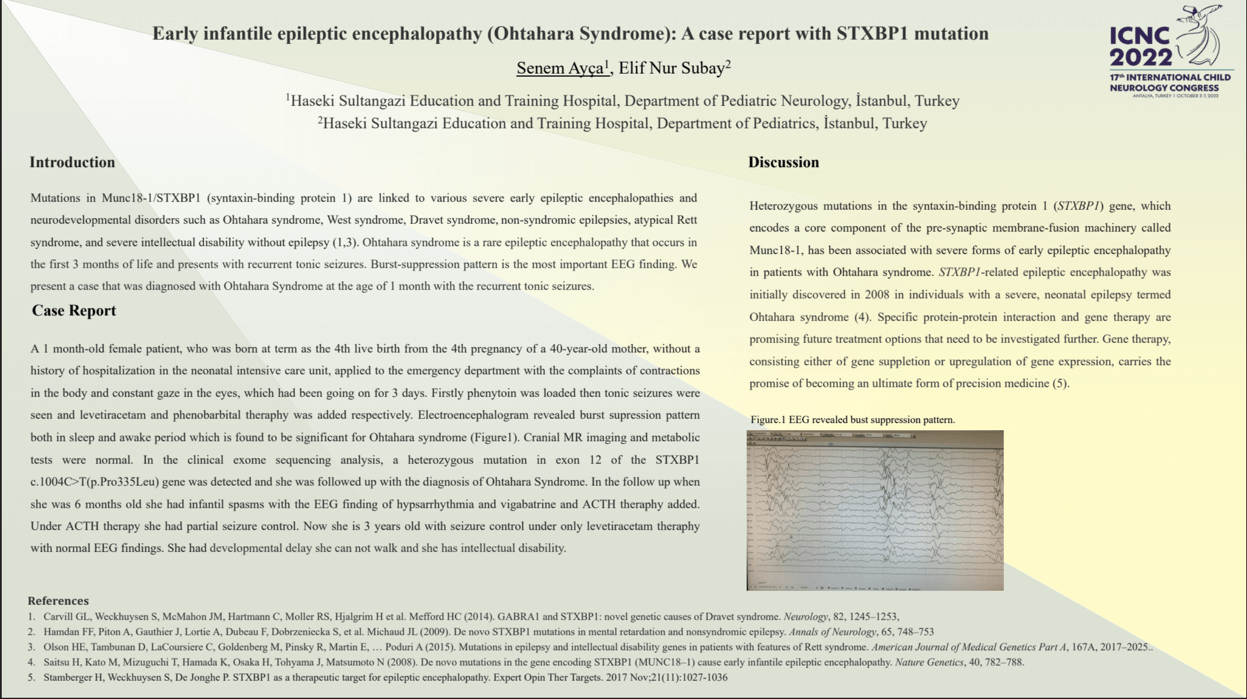Early infantile epileptic encephalopathy (Ohtahara Syndrome): A case report with STXBP1 mutation
Senem Ayca, Elif Nur Subay
Introduction: Ohtahara syndrome is a rare epileptic encephalopathy that occurs in the first 3 months of life and presents with recurrent tonic seizures. Burst-suppression pattern is the most important EEG finding. We present a case that was diagnosed with Ohtahara Syndrome at the age of 1 month with the recurrent tonic seizures. Case report: A 1-month-old female patient, who was born at term as the 4th live birth from the 4th pregnancy of a 40-year-old mother, without a history of hospitalization in the neonatal intensive care unit, applied to the emergency department with seizure which had been going on for 3 days. Firstly phenytoin was loaded then tonic seizures were seen and levetiracetam and phenobarbital theraphy was added respectively. Electroencephalogram revealed burst supression pattern which is found to be significant for early infantile epileptic encephalopathy. Cranial MR imaging and metabolic tests were normal. In the clinical exome sequencing analysis, a heterozygous mutation in exon 12 of the STXBP1 gene was detected and she was followed up with the diagnosis of Ohtahara Syndrome. In the follow up when she was 6 months old she had infantil spasms with the EEG finding of hypsarrhythmia and under ACTH therapy she had partial seizure control. She had developmental delay and intellectual disability. Discussion: STXBP1-related epileptic encephalopathy was initially discovered in 2008 in individuals with a severe, neonatal epilepsy termed Ohtahara syndrome. The STXBP1 gene should be kept in mind in children with Ohtahara syndrome.
Keywords: Ohtahara syndome, epilepsy, STXBP1
Senem Ayca
Haseki Sultangazi Education and Training Hospital
Turkey
Elif Nur Subay
Haseki Sultangazi Education and Training Hospital
Turkey
Introduction: Ohtahara syndrome is a rare epileptic encephalopathy that occurs in the first 3 months of life and presents with recurrent tonic seizures. Burst-suppression pattern is the most important EEG finding. We present a case that was diagnosed with Ohtahara Syndrome at the age of 1 month with the recurrent tonic seizures. Case report: A 1-month-old female patient, who was born at term as the 4th live birth from the 4th pregnancy of a 40-year-old mother, without a history of hospitalization in the neonatal intensive care unit, applied to the emergency department with seizure which had been going on for 3 days. Firstly phenytoin was loaded then tonic seizures were seen and levetiracetam and phenobarbital theraphy was added respectively. Electroencephalogram revealed burst supression pattern which is found to be significant for early infantile epileptic encephalopathy. Cranial MR imaging and metabolic tests were normal. In the clinical exome sequencing analysis, a heterozygous mutation in exon 12 of the STXBP1 gene was detected and she was followed up with the diagnosis of Ohtahara Syndrome. In the follow up when she was 6 months old she had infantil spasms with the EEG finding of hypsarrhythmia and under ACTH therapy she had partial seizure control. She had developmental delay and intellectual disability. Discussion: STXBP1-related epileptic encephalopathy was initially discovered in 2008 in individuals with a severe, neonatal epilepsy termed Ohtahara syndrome. The STXBP1 gene should be kept in mind in children with Ohtahara syndrome.
Keywords: Ohtahara syndome, epilepsy, STXBP1
Senem Ayca
Haseki Sultangazi Education and Training Hospital
Turkey
Elif Nur Subay
Haseki Sultangazi Education and Training Hospital
Turkey

Senem Ayca
Haseki Sultangazi Education and Training Hospital Turkey
Haseki Sultangazi Education and Training Hospital Turkey